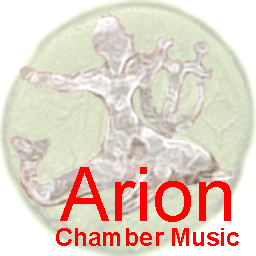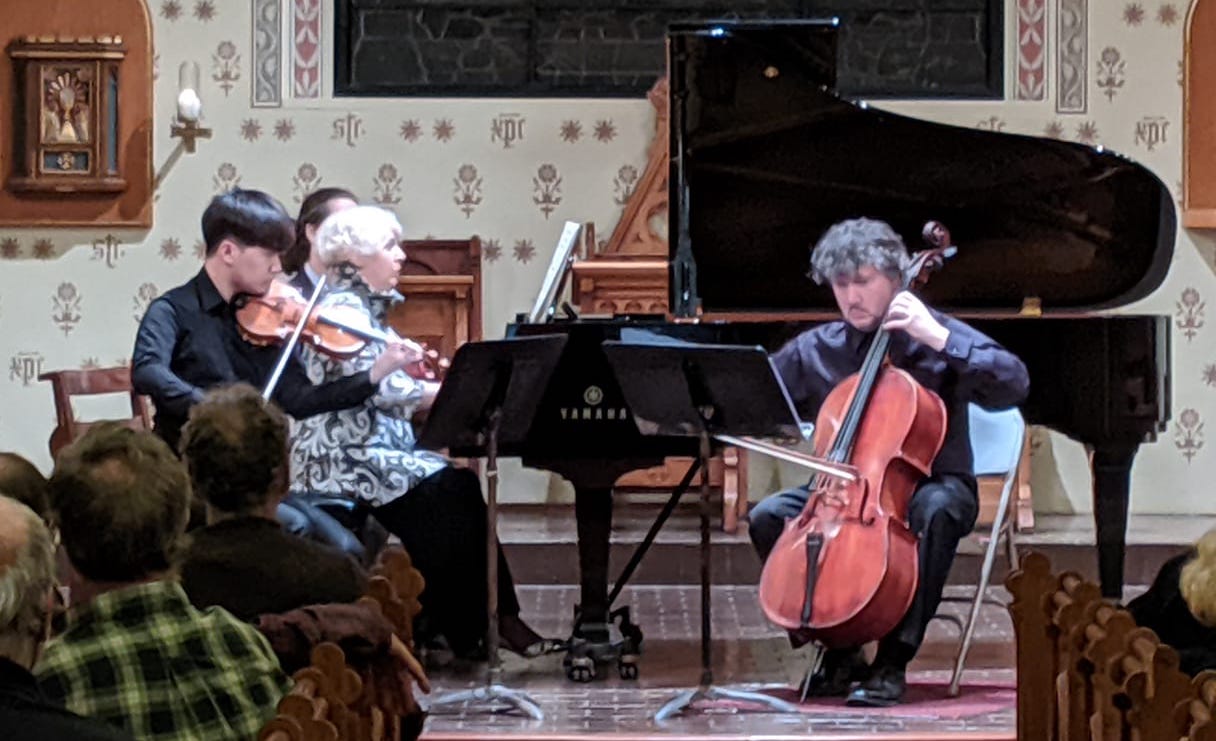 |
|
|
2019/2020 concerts Other Arion seasons |
Friday, November 8th, 2019 at 8 pmChrist and St. Stephen's Church, 120 West 69th Street, NYCViolinist William Wei and pianist Inessa Zaretsky return to join cellist Robert La Rue in a mixed program of duets and piano trios, featuring Beethoven’s Sonata, Op. 30 No. 3 for violin and piano, Nadia Boulanger’s Three Pieces for Cello and Piano (1914), and Sergei Rachmaninoff’s Trio élégiaque No. 2 in D minor, Op. 9. Artists
Notes on the Program Ludwig van Beethoven (1770 --1827) Sonata in G major, Op. 30 # 3 “Schuppanzigh ist ein Lump, Lump, Lump…..” So begins Beethoven’s Lob auf den Dicken ( “Praise for the Fat One”), WoO 100, a short choral work mocking Ignaz Schuppanzigh for his gross corpulence. In it, Schuppanzigh is hailed (among other things) as a ‘fat sour-belly’ and an ’inflated ass’s head’. It was thus, with typical grace and charm, that Beethoven chose to acknowledge his long professional and personal relationship with the violinist. This began as early as 1792, when Beethoven studied the violin with Schuppanzigh in Vienna; he is believed to have taken as many as three lessons a week for a period of several months. Over time, these lessons were transformed into occasional workshopping sessions in which Beethoven would read through his new compositions with Schuppanzigh -- a process that began already with the Op. 1 piano trios and continued through the writing of the violin sonatas, Opp. 12, 23, 24 and 30. The three sonatas for piano and violin, Op. 30, were completed in 1802 -- the year of Beethoven’s Heiligenstadt Testament, in which he wrote about his despair over his increasing deafness, his contemplation of suicide, and his determination to persist in the completion of what he saw as his artistic destiny -- to “seize fate by the throat,” as he said elsewhere. In this respect he drew inspiration from two leaders who appeared to him (as they did to much of the world at the time) to be doing exactly that: Napoleon Bonaparte and Tzar Alexander I of Russia. Bonaparte famously lost his dedication -- of what became the ‘Eroica’ Symphony -- when he declared himself Emperor. The dedication of the Opus 30 violin sonatas, to Alexander (who visited Vienna in 1802), was never removed. The months that Beethoven spent at Heiligenstadt are typically seen as the dividing line between his ‘Early’ and ‘Middle’ Periods. The last of the Op. 30 Sonatas -- No. 3 in G Major -- marks a fitting conclusion to the ‘Early’ Period (at least as far as the composer’s works for violin), containing as it seems to all that Beethoven had learned of Mozart (by way of his detailed study of Mozart’s violin sonatas with Neefe in Bonn) and Haydn (during his period of study with the Master in Vienna). Remarkably, this sonata bears no hint of the despair with which Beethoven was struggling at the time of its composition. It is a work (rare in Beethoven’s output) of virtually unalloyed sunniness and good spirits -- to such an extent that it doesn’t even include what is typically called a ‘slow movement’. It is sometimes given the nickname of the ‘Champagne’ Sonata. Nadia Boulanger (1887 -- 1979) Three Pieces for Cello and Piano (1914) “If there is one thing of which I am certain, it is that I wrote useless music.” -- Nadia Boulanger Born in Paris on her father’s 72nd birthday, Juliette Nadia Boulanger was the daughter of a composer who had shown enough early promise to win the Prix de Rome in his youth, wrote comic operas and became respected for his choral music, and taught singing at the Paris Conservatoire. Her mother, who claimed descent from the upper reaches of the Russian aristocracy but seems to have been working as a governess when she met her much older husband in Russia, subsequently followed him to Paris, where she became enrolled in his class at the Conservatoire. They married in 1877. Nadia was born a decade later and, in her earliest years, displayed a marked aversion to music, complaining loudly when it was played and running away to hide until it stopped. This changed abruptly around the time of the birth of her younger sister, Lili (who later also began a career as a composer by becoming the first woman to win the Prix de Rome, but died young). Nadia became a serious and devoted student of music, entering the Paris Conservatoire at the age of nine in 1896 and completing her studies in 1904. She was a composition pupil of Fauré and, at graduation, took First Prizes in organ, piano accompaniment, and fugue-writing. It was the death of her father, in 1900, that first caused her to consider teaching (as a means of contributing to her family’s income). She began taking in pupils even before completing her Conservatoire studies and by 1905 was holding weekly group classes in sight-singing and theory in addition to private lessons. At the same time she entered her most active period of composition, with the specific goal of winning the Rome Prize. (She never succeeded in matching her father and younger sister in this respect.) Following the end of the First World War, Boulanger was invited by Alfred Cortot to teach at the newly founded Ecole normale de musique. Two years later (as the result of prompting by General Pershing, with the initial goal of improving the quality of music for U.S. military bands) the American Conservatory at Fontainebleau was founded, and Boulanger began her long association with it as a professor of harmony. Aaron Copland was in her class in this very first year. Over the ensuing decades at Fontainebleau and in Paris (additionally -- during the WWII Nazi occupation of France -- at the Peabody Conservatory and the Longy School of Music in the U.S.), Boulanger would exert her legendary, outsize influence over generations of American composers as diverse as Copland, Elliott Carter, Phillip Glass, and Quincy Jones. (George Gershwin sought her out but was rejected after half an hour’s conversation: “I can teach you nothing.”) Virgil Thomson remarked that every town in America could boast two things: a ‘five-and-’dime’ store, and a student of Nadia Boulanger. She also had a distinguished career as a conductor, being the first woman to conduct several notable European and American orchestras (including the Royal Philharmonic and Hallé orchestras in Britain, and the Boston Symphony, Philadelphia Orchestra, and New York Philharmonic in the U.S.). Additionally, she held the position of kapellmeister to the Princes of Monaco, in which capacity she selected and organized the music for the wedding of Grace Kelly to Prince Rainier. The Three Pieces for Cello and Piano are in fact Boulanger’s own reworking of pieces which she composed for organ in 1911. The first, Moderato (entitled “Improvisation” in the original organ version), is a song without words in muted E-flat minor. The second, Sans vitesse et à l’aise (‘without speed and at ease’) originally bore the title: “Petit Canon”, and it is exactly that. The cello and piano pursue each other closely through the course of the piece in a dreamy Aeolian mode. The last, Vite et nerveusement rhythmé (“fast and rhythmically nervous”), contrasts dramatically with the preceding pieces: a lively 2/4 in C# minor, with a middle section of Latin character in 5/4. Though there is nothing here that can be called strikingly original (flavors of Fauré and Debussy abound), with its direct, eloquent expressiveness, this is far from ‘useless music’. Sergei Rachmaninoff (1873--1943) Trio élégiaque No. 2, Op. 9 A little over a decade after Rachmaninoff’s death, the 1954 edition of Grove’s Dictionary of Music and Musicians unenthusiastically described his music as “monotonous in texture” and opined that it “consists mainly of artificial and gushing tunes”. Somewhat sniffily, it noted Rachmaninoff’s popular success but predicted that this was “not likely to last”. Making predictions is a tricky business. A comparison with his near contemporaries Charles Ives, Arnold Schoenberg (both born in 1874), Maurice Ravel (1875) or even his classmate Alexander Scriabin (1871) reveals Rachmaninoff as an intensely conservative composer. Firmly rooted from the outset in 19th century Russian Romanticism (he was, after all, a student of Arensky and looked both to Tchaikovsky and Taneyev as mentors), his music would remain that way for the rest of his active compositional life. As one of the last prominent examples of a musician known to audiences equally as an instrumental performer and a composer, Rachmaninoff was also far more a creature of the old 19th century tradition than of the new 20th. Some of this may have been the result of precocity. By the time he was 20 and had graduated from the Moscow Conservatory, he had not only been awarded the school’s Great Gold Medal for his one-act opera, Aleko (programmed shortly thereafter by the Bolshoi Theater and performed by Chaliapin) but had also written what was to remain one of his signature pieces throughout his career: the famous Prelude in C# minor. He was perhaps, in a certain sense, ‘formed’ early as a composer. The story of his First Symphony’s disastrous premiere and his subsequent three-year period of depression and inactivity, finally alleviated by a combined course of hypno- and psychotherapy, is well known. In a different sort of composer, such an experience might have been expected to lead to some species of radical change -- or, at the very least, a striking out in a significant new direction -- rather than what could be (indeed, has been) viewed as a failure to develop. Whatever doubts and insecurities he may have suffered, he seems ultimately never to have questioned either the value or the durability of the tradition he had inherited. In writing his second Trio élégiaque, Rachmaninoff was very consciously honoring that inheritance, in the person of Pyotr Ilyich Tchaikovsky. He began work on the piece almost immediately upon hearing the news of Tchaikovsky’s death. There is something of a tradition, among Russian composers, of writing memorial piano trios. Rachmaninoff’s composition teacher, Anton Arensky, dedicated his D minor piano trio to the memory of the cellist, Karl Davydov. And Tchaikovsky’s own piano trio carried a dedication -- ‘To the memory of a great artist’ -- with reference to the pianist, Nikolai Rubinstein. Rachmaninoff used exactly these same words in dedicating his trio to Tchaikovsky. Certain thematic and formal similarities between the two trios bear out this relationship. The work is conceived on a grand scale in three movements, the first two of which are the more allusively ‘memorial’ in adhering to Tchaikovsky’s trio as a model. A sprawling, loosely-structured sonata form first movement is followed, in the second, by an elaborate Theme & Variations. Whereas Tchaikovsky finished his trio with two movements, Rachmaninoff added a comparatively brief third, which can be understood as a sort of afterword in which the young composer gave unrestrained expression to his personal sensations of grief and loss. The return, at the very end, of the first movement’s opening theme gives the piece as a whole a cyclical, closed feel. Program Notes © 2019 Robert La Rue |
